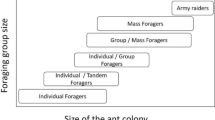Abstract
Workers of the Argentine ant, Iridomyrmex humilis,start to explore a chemically unmarked territory randomly. As the exploratory front advances, other explorers are recruited and a trail extends from it to the nest. Whereas recruitment trails are generally constructed between two points, these exploratory trails have no fixed destination, and strongly resemble the foraging patterns of army ants. A minimal model shows how the exploratory pattern may be generated by the individual workers' simple trail-laying and -following behavior, illustrating how complex collective structures in insect colonies may be based on self-organization.
Similar content being viewed by others
References
Aron, S., and Pasteels, J. M. (1988). Spatial organisation in the Argentine ant,Iridomyrmex humilis (Mayr).Acta Coll. Ins. Soc. 203–210.
Aron, S., Pasteels, J. M., and Deneubourg, J. L. (1989). Trail-laying behaviour during exploratory recruitment in the Argentine ant,Iridomyrmex humilis (Mayr).Biol. Behav 14: 207–217.
Arthur, W. B., Ermoliev, Y. M., and Kaniovski, Y. M. (1986). Path-dependent processes and the emergence of macro-structure.Eur. J. Op. Res.30.
Cavill, J. W. K., Robertson, P. C., and Davies, N. W. (1979). An Argentine ant aggregation factor.Experientia 35: 989–990.
Deneubourg, J. L. (1977). Application de l'ordre par fluctuations à la description de certaines étapes de construction du nid chez les termites.Ins. Soc. 24: 117–130.
Deneubourg, J. L., Goss, S., Pasteels, J. M., Fresneau, D., and Lachaud, J. P. (1987). Self-organization mechanisms in ant societies (II). Learning to forage and division of labor. In Pasteels, J. M., and Deneubourg, J. L. (eds.),From Individual to Collective Behavior in Social Insects, Birkhäuser, Basel, pp. 177–196.
Deneubourg, J. L., Goss, S., Franks, N., and Pasteeis, J. M. (1989). The blind leading the blind: Modeling chemically mediated army ant raid patterns.J. Insect Behav. 2: 719–725.
Focardi, S., Deneubourg, J. L., and Chelazzi, G. (1985). How shore morphology and orientation mechanisms can affect the spatial organization of intertidal molluscs.J. Theor. Biol. 112: 771–782.
Franks, N. R., and Fletcher, C. R. (1983). Spatial patterns in army ant foraging and migration:Eciton burchelli on Barro Colorado Island, Panama.Behav. Ecol. Sociobiol. 12: 261–270.
Gordon, D. M. (1988). Group-level exploration tactics in fire ants.Behaviour 104: 162–175.
Goss, S., and Deneubourg, J. L. (1988). Autocatalysis as a source of synchronised rhythmical activity in social insects.Soc. Ins. 35: 310–315.
Goss, S., and Deneubourg, J. L. (1989). The self-organising clock pattern of Messor pergandei (Formicidae, Myrmicinae).Soc. Ins. 36: 339–346.
Grassé, P. P, (1939). La reconstruction du nid et le travail collectif chez les termites supérieurs.J. Psychol. Pathol. Gén. 370–396.
Grassé, P. P. (1959). La reconstruction du nid et les coordinations interindividuelles chezBellicositermes natalensis etCubitermes sp. La théorie de la stigmergie: Essai d'interprétation des termites constructeurs.Ins. Soc. 6: 41–83.
Haken, H. (1983).Synergetics, Springer-Verlag, Berlin.
Keller, E. F., and Segel, L. I. (1970). Initiation of slime-mould aggregation viewed as an instability.J. Theor. Biol. 26: 399–415.
Moffet, M. W. (1984). Swarm raiding in a myrmicine ant.Naturwissenschaften 71: 588–590.
Moffet, M. W. (1988). Foraging dynamics in the group-hunting myrmicine ant,Pheidologeron diversus.J. Insect Behav. 71: 588–590.
Nicolis, G., and Prigogine, I. (1977).Self-Organization in Non-Equilibrium Systems, Wiley, New York.
Oster, G. F., and Wilson, E. O. (1978).Caste and Ecology in the Social Insects, Princeton University Press, Princeton, N.J.
Pasteels, J. M. (1965). Polyéthisme chez les ouvrières deNasutitermes lujae (Termitidae Isoptères).Biol. Gabon. 1: 191–205.
Pasteels, J. M., Deneubourg, J. L., and Goss, S. (1987). Self-organization mechanisms in ant societies (I). Trail recruitment to newly discovered food sources. In Pasteels, J. M., and Deneubourg, J. L. (eds.),From Individual to Collective Behavior in Social Insects, Birkhäuser, Basel, pp. 155–176.
Prigogine, I., and Stengers, I. (1984).Order Out of Chaos, Bantam, New York.
Rettenmeyer, C. W. (1963). Behavioral studies of army ants.Univ. Kans. Sci. Bull. 44: 281–465.
Rickli, M., and Leuthold, R. H. (1986). Spatial organisation during exploration and foraging in the harvester termite. Trinervitermes germinatus.Rev. Suisse Zool. 94: 545–551.
Schieve, W. C., and Allen, P. (eds.) (1982).Self-Organization and Dissipative Structures, University of Texas Press, Austin.
Schneirla, T. C. (1940). Further studies on the army ant behavior pattern.J. Comp. Psychol. 29: 401–461.
Schneirla, T. C. (1971). In Topoff, H. R. (ed.),Army Ants: A Study in Social Organization, Freeman, San Francisco.
Topoff, H. R. (1972). The social behavior of army ants. In Eisner, T., and Wilson, E. O. (eds.), The Insects, Scientific American, Freeman, San Francisco, pp. 247–262.
Turing, A. M. (1952). The chemical basis of morphogenesis.Phil. Trans. Roy. Soc. Lond. B 237: 37–72.
Van Vorhis Key, S. E., and Baker, T. C. (1982). Trail-following responses of the Argentine ant,Iridomyrmex humilis (Mayr), to a synthetic trail pheromone component and analogs.J. Chem. Ecol. 8: 3–14.
Van Vorhis Key, S. E., and Baker, T. C. (1986). Observations on the trail deposition and recruitment behaviors of the Argentine ant.Iridomyrmex humilis (Hymenoptera: Formicidae).Ann. Entomol. Soc. Am. 79: 283–288.
Wilson, E. O., and Hölldobler, B. (1988). Dense heterarchies and mass communication as the basis of organization in ant colonies.Tree 3: 65–67.
Author information
Authors and Affiliations
Rights and permissions
About this article
Cite this article
Deneubourg, J.L., Aron, S., Goss, S. et al. The self-organizing exploratory pattern of the argentine ant. J Insect Behav 3, 159–168 (1990). https://doi.org/10.1007/BF01417909
Accepted:
Issue Date:
DOI: https://doi.org/10.1007/BF01417909




